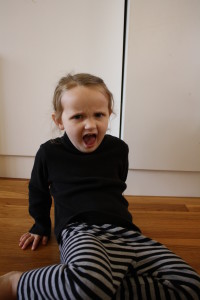 One of the major ideas of peaceful parenting is that what we often term “misbehavior” is actually an expression of an underlying need. In the past several decades, parents have gotten pretty good at applying this idea to babies. Most of us are on board with the idea that a crying baby is a baby who needs something, not a baby who’s trying to be manipulative or make us miserable. But as that baby becomes a toddler, and then a full-fledged kiddo, it can be harder to keep this idea of underlying needs in mind. What’s more, even if we do embrace this idea, it can be a challenge to figure out just what the underlying need is.
One of the major ideas of peaceful parenting is that what we often term “misbehavior” is actually an expression of an underlying need. In the past several decades, parents have gotten pretty good at applying this idea to babies. Most of us are on board with the idea that a crying baby is a baby who needs something, not a baby who’s trying to be manipulative or make us miserable. But as that baby becomes a toddler, and then a full-fledged kiddo, it can be harder to keep this idea of underlying needs in mind. What’s more, even if we do embrace this idea, it can be a challenge to figure out just what the underlying need is.
When I speak about this aspect of peaceful parenting to groups, parents often ask me just how can decipher their child’s needs. We’d love a formula: if child does this, he needs that. Obviously, our small fry are far too complicated to reduce to a list of behaviors and corresponding needs! But there are several questions we can ask ourselves that can help us to get some clarity.
Is there a physical need?
Is she hungry or thirsty? Overtired or overstimulated? Could he be getting sick?
Is there a developmental need?
We all know there are certain stages in which children are highly motivated to achieve developmental milestones. A baby learning to walk won’t do well in a setting where he must be held for a long time. A child exploring the concept of autonomy may have trouble in a situation where she has no choices. We must ask ourselves: is my child in a situation or setting which does not allow for this developmental need to be met?
Is there a big emotion?
Our kids may be living in small bodies, but they can experience BIG emotions which they may need our help to navigate.
Is there a disconnect?
The parent-child connection is essential to a child’s well-being. When they sense a disconnect, their behavior will raise a red flag, so to speak. Sometimes the disconnect is obvious – maybe we’ve been away for several hours. But it can often be more subtle – talking on the phone, for instance, or using the computer. Maybe we’re entertaining a guest. Or perhaps we’re dealing with our own big emotions – we’re worried or upset about something which is preventing us from being truly present.
Figuring out the need under the behavior can be a challenge – especially at first. But the more connected we are to our children, and the more often we practice identifying their needs, the easier it becomes.
I am a former home school mom, currently a charter school teacher , who is looking for ideas to make my new position as a kindergarten teacher accessible for project/interest based learning for at least half of our school day. yes, I know; with 20 kids in much of the same age range, it will be a challenge. And yes, part of my job is to see that minimum standards are met. However, the administration is more interested in a student showing some progress each trimester rather than being graded. I will be interested in reading your blog from time to time in the hope of finding ideas that will help me successfully implement learning from a project-based approach.
That sounds like a wonderful challenge! It’s great to hear about school administrators who are brave enough to think outside the box and allow their teachers and students the freedom to try something new. I wish you much success!
I recently saw a video in which an Irish unschooling mom said that kids don’t become “cognitive” until they’re 12 or 13. Meaning, they have trouble making sense of the world. This helped me a lot, b/c my son would be considered as having severe ADHD, so his emotions flare up quickly and intensely. I’m a long ways from where I want to be as far as responding in love instead of wanting to run away to a small island in the Pacific, but realizing that his 10yo brain just can’t process difficulties the way it will be able to do in a few yrs is helping me to – slowly, gradually, but I think surely – become a more peaceful parent.
Thanks for sharing this!